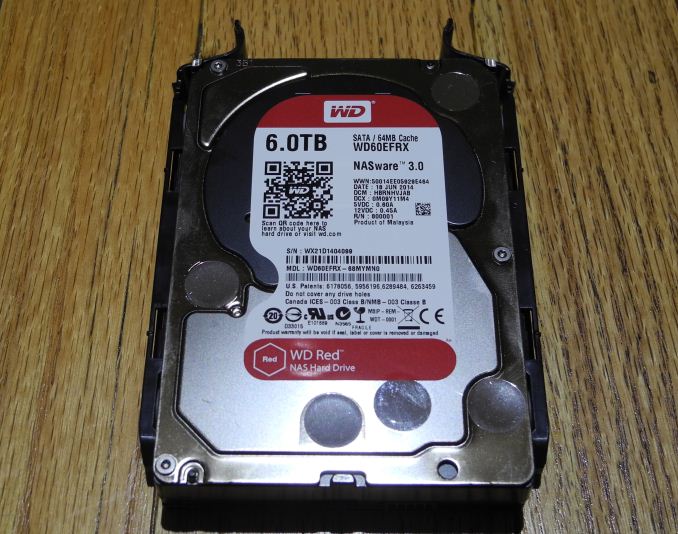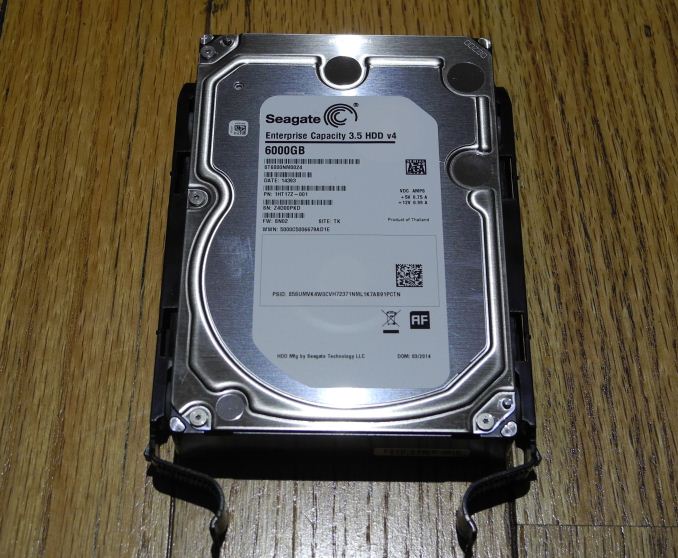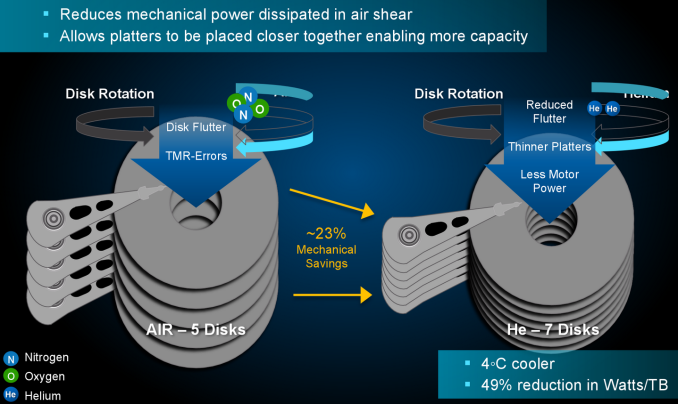6 TB NAS Drives: WD Red, Seagate Enterprise Capacity and HGST Ultrastar He6 Face-Off
by Ganesh T S on July 21, 2014 11:00 AM EST6 TB Face-Off: The Contenders
Prior to getting into the performance evaluation, we will take a look at the special aspects and compare the specifications of the three drives being considered today.
Western Digital Red 6 TB
The 6 TB Red's claim to fame is undoubtedly its areal density. While Seagate went in for a six-platter design for its 6 TB drives, Western Digital has managed to cram in 1.2 TB/platter and deliver a 6 TB drive with the traditional five platter design. The costs are also kept reasonable because of the use of traditional PMR (perpendicular magnetic recording) in these drives.
The 6 TB drive has a suggested retail price of $299, making it the cheapest of all the three drives that we are considering today.
Seagate Enterprise Capacity 3.5 HDD v4 6 TB
Seagate was the first to utilize PMR to deliver a 6 TB enterprise drive earlier this year. They achieved this through the use of a six platters (compared to the traditional five that most hard drives use at the maximum). A downside of using six platters was that the center screw locations on either side got shifted, rendering some drive caddies unable to hold them properly. However, we had no such issues when trying to use the QNAP rackmount's drive caddy with the Seagate drive.
Seagate claims best in class performance, and we will be verifying those claims in the course of this review. Pricing ranges from around $450 on Amazon (third party seller) to $560 on Newegg.
HGST Ultrastar He6 6 TB
The HGST Ultrastar He6 is undoubtedly the most technologically advanced drive that we are evaluating today. There are two main patented innovations behind the Ultrastar He6, HelioSeal and 7Stac. The former refers to placement of the platters in a hermetically sealed enclosure filled with helium instead of air. The latter refers to packaging of seven platters in the same 1" high form factor of traditional 3.5" drives.
With traditional designs, we have seen a maximum of six platters in a standard 3.5" drive. The additional platter is made possible in helium filled drives because the absence of air shear reduces flutter and allows for thinner platters. The motor power needed to achieve the same rotation speeds is also reduced, thereby lowering total power dissipation. The hermetically sealed nature of the drives also allows for immersive cooling solutions (placement of the drives in a non-conducting liquid). This is something not possible in traditional hard drives due to the presence of a breather port.
The TCO (total cost of ownership) is bound to be much lower for the Ultrastar He6 compared to other 6 TB drives when large scale datacenter applications are considered (due to lower power consumption, cooling costs etc.). The main issue, from the perspective of the SOHOs / home consumers, is the absence of a tier-one e-tailer carrying these drives. We do see third party sellers on Amazon supplying these drives for around $470.
Specifications
The various characteristics / paper specifications of the drives under consideration are available in the table below.
| 6 TB NAS Hard Drive Face-Off Contenders | |||
| WD Red | Seagate Enterprice Capacity 3.5" HDD v4 | HGST Ultrastar He6 | |
| Model Number | WD60EFRX | ST6000NM0024 | HUS726060ALA640 |
| Interface | SATA 6 Gbps | SATA 6 Gbps | SATA 6 Gbps |
| Advanced Format (AF) | Yes | Yes | No (512n) |
| Rotational Speed | IntelliPower (5400 rpm) | 7200 rpm | 7200 rpm |
| Cache | 64 MB | 128 MB | 64 MB |
| Rated Load / Unload Cycles | 300K | 600K | 600K |
| Non-Recoverable Read Errors / Bits Read | 1 per 10E14 | 1 per 10E15 | 1 per 10E15 |
| MTBF | 1M | 1.4 M | 2M |
| Rated Workload | ~120 - 150 TB/yr | < 550 TB/yr | < 550 TB/yr |
| Operating Temperature Range | 0 - 70 C | 5 - 60 C | 5 - 60 C |
| Physical Dimensions | 101.85 mm x 147 mm x 26.1 mm. / 680 grams | 101.85 mm x 147 mm x 26.1 mm / 780 grams | 101.6 mm x 147 mm x 26.1 mm / 640 grams |
| Warranty | 3 years | 5 years | 5 years |
The interesting aspects are highlighted above. Most of these are related to the non-enterprise nature of the WD Red. However, two aspects that stand out are the multi-segmented 128 MB cache in the Seagate drive and the HGST He6 drive's lower weight despite having more platters than the other two drives.













83 Comments
View All Comments
JohnMD1022 - Thursday, July 24, 2014 - link
Actually, yes.I have seen too many bad Seagate drives to use or recommend.
At one point, I had 9 bad Seagates in my shop at the same time.
In addition, their customer service leaves a lot to be desired.
comomolo - Monday, July 21, 2014 - link
Have you actually read the article?It's clearly written that the drive DID NOT fail. The drive in question passed all the tests and ran perfectly fine by itself on a PC. The author states this looks like a compatibility issue with QNAP's server.
GTVic - Monday, July 21, 2014 - link
A lot of people claim the failure is related to shipping methods, particularly blaming Newegg on this. Proper shipping = reliable drive. I'd believe that sooner than "WD Red sucks" comments.Wixman666 - Tuesday, July 22, 2014 - link
I have a sea of WD Red hard drives out in the field at various customer locations. I've only ever had one fail.romrunning - Monday, July 21, 2014 - link
I don't understand - if you had both WD Red and WD Red Pro drives (according to your other quick note on these new drive models), why didn't you review the WD Red Pro?ganeshts - Monday, July 21, 2014 - link
As I wrote in the pipeline section, the WD Red Pro review will come next week.This is for the 6 TB capacity.
The 4TB versions' review will include the WD Red Pro (sometime next week)
continuum - Saturday, July 26, 2014 - link
http://forums.storagereview.com/index.php/topic/36...Claims there's an early model issue on the regular WD Red's causing them to be invalid? But that's the only site I've heard of claiming this...
Rythan - Monday, July 21, 2014 - link
I've gone through this article a couple of times - where are the idle and load power numbers?ganeshts - Monday, July 21, 2014 - link
I will add them later tonight (along with the missing He6 benchmark numbers).romrunning - Tuesday, July 22, 2014 - link
Ah... It just seems that some of your numbers in this face-off would change if the WD drive was 7200rpm instead of 5400rpm. Perhaps that would affect your conclusion as well. But I suppose if you didn't get a 6TB WD Red Pro drive, then it's a moot point.